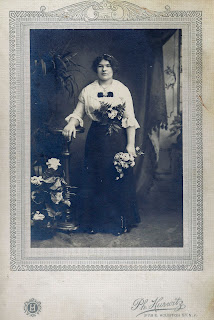 |
| Marya Klak, between 1911-1914 |
 |
| Marya Klak and John Nyznyk, November 11, 1914 |
She married John Nyznyk on November 11, 1914, in St. George Ukrainian Catholic Church, in New York City. Although Marya was Polish, her husband was Ukrainian. He was a harness maker, and according to family stories, served in the Austrian Army. He also was a widower, and father of two children, Paul and Michelina, who were living in his home town of Pomorzany. My father, Peter Paul, was born August 18, 1915 in Bellvue Hospital. At the time, Marya and John were living on East 92nd Street in New York City.
Shortly after Peter's birth, John and Marya separated. I haven't found any records of where Marya and Peter lived during this time, but I have to assume that they lived with members of her family in New York City. My father told me that his mother found a day nursery where working mother could leave their children, and enrolled him there. Later, she enrolled him in a school operated by the Children's Aid Society of New York, where he attended until the fourth grade. Marya worked several jobs, including a summer as a cook for a children's camp in upstate New York. My father stayed with a family in the area and he remembers their collie dog fondly.
 |
| Peter Noznick in Central Park NYC 1920's |
.jpg) |
| Peter Noznick 1917 |
Sometime between 1915 and 1920, Marya met and married Peter Zackowski, another Polish immigrant. The family lived on Ave C across from the Eagle Pencil Factory. There was a fire station nearby and the horse drawn steam fire engines terrified my father. They moved to 624 East Eleventh St, between Avenue B and C, and lived there until they moved to Connecticut. They worked several jobs and saved every penny until they had enough money to buy a farm in Windham Connecticut in 1930. Moving to an old colonial house was a big change for Marya, she had never lived in a house that large in her life. She wall-papered every room and furnished it with pieces from area farm sales.
Sometime during these years, she became known as Mary.
 |
| The Farm in Windham Connecticut, 1940's |
Marya lived in Connecticut for the rest of her life. She missed living in New York and having her friends and family nearby. She did see them regularly, since they came to the farm for visits almost every summer. They called her "Choch" which was a shorted form of auntie in Polish. Marya and Peter ran a dairy farm until the late 1950's, when electric milking machine became the norm. They continued to sell milk, eggs and hay into the 1960's. Her son, Peter had three children, Pauline, Peter and Andrew, who spent many summers at the farm. There was plenty to do there, even through there was no TV. There wan an old radio and an old Victrola record player, which required cranking to operate, as well as 100 acres of farmland and woods to explore.
 |
| Mary and her cows, Windham Center Connecticut 1960's |
 |
| Mary Zackowski, Peter, Julia, Pauline and Peter Noznick 1949 |
Peter Zackowski died in 1963. Shortly after his death, some friends brought Mary a puppy, who she named Skipper, he was her companion for the last years of her life. Mary died in 1969, a few weeks before the Astronauts landed on the moon. Peter and Mary Zackowski are buried in the Windham Center Cemetery, next to son and daughter-in-law Peter and Julia Noznick.


